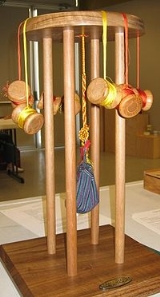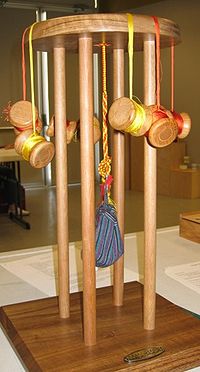
Marudai
Encyclopedia

Kumihimo
Kumihimo is a Japanese form of braid-making. Cords and ribbons are made by interlacing strands.-History:Kumihimo cord was first created by a form of finger-loop braiding. Later tools such as the marudai and the takadai were employed to make more complex braids in shorter time...
, a type of Japan
Japan
Japan is an island nation in East Asia. Located in the Pacific Ocean, it lies to the east of the Sea of Japan, China, North Korea, South Korea and Russia, stretching from the Sea of Okhotsk in the north to the East China Sea and Taiwan in the south...
ese braid. The Japanese style marudai is 16" (40cm) high and is usually used while kneeling or when placed on a table. The Western style 26" marudai allows the braider to sit in a chair to braid. They are most commonly made out of wood, although sometimes plastic is the chosen material. Unlike kumihimo
Kumihimo
Kumihimo is a Japanese form of braid-making. Cords and ribbons are made by interlacing strands.-History:Kumihimo cord was first created by a form of finger-loop braiding. Later tools such as the marudai and the takadai were employed to make more complex braids in shorter time...
disks, marudais have no indication of where the thread should be placed; it is done freehand. To create the tension required for the rope to form, tama are rolled on the strands of threads, and a bag of counterweights are place at the base knot of these threads, where the rope begins. The tama are wooden bobbin
Bobbin
A bobbin is a spindle or cylinder, with or without flanges, on which wire, yarn, thread or film is wound. Bobbins are typically found in sewing machines, cameras, and within electronic equipment....
s that are often filled with lead or other heavy metals.
Terms related to marudai
- Kagami
- Kongō Gumi - a class of patterns for round cord all involving eight threads folded in half for a total of sixteen strands. In clockwise order, each bobbins is moved to the opposite side. When different combinations of thread color are used, many interesting patterns emerge, including diagonal stripes, diamonds on a background, triangles resembling hearts, and tiny six-petalled flowers. Kongō Gumi is named for the venerable Kongō GumiKongo Gumiis a Japanese construction company and was the world's oldest continuously ongoing independent company, operating for over 1,400 years until it was absorbed as a subsidiary of another larger construction company...
company of Japan. - KumihimoKumihimoKumihimo is a Japanese form of braid-making. Cords and ribbons are made by interlacing strands.-History:Kumihimo cord was first created by a form of finger-loop braiding. Later tools such as the marudai and the takadai were employed to make more complex braids in shorter time...
or kumi himo - Japanese for "gathered threads". - ObiObiObi may refer to:* Obi , a sash worn with a kimono or with the uniforms used by practitioners of Japanese martial arts* Obi-Wan Kenobi, fictional character from the Star Wars universe...
- the broad cloth sash used in traditional dress. - Obijime - the cord used to bind the obi secure.
- Omori
- TakadaiTakadaiA takadai , also called kōdai, is a frame used for making kumihimo, a type of Japanese braid. The braids created on the takadai are flat as opposed to the braids created on the marudai which have a round or polygonal section. The threads are attached to weighted bobbins called tamas and lay on...
- a rectangular or square frame for kumihimo. - Tama - little spools. The thread is kept from unwinding by passing the thread under itself, forming a loop around the tama. True silk is a hollow fiber with a rough surface that resists slipping past the loop unless gently pulled. For synthetic fibers, a flexible plastic "clamshell" bobbin may be preferable.

Books
- Creative Kumihimo, Jacqui Carey
- Beginner's Guide to Braiding, the Craft of Kumihimo, Jacqui Carey (Search Press)

